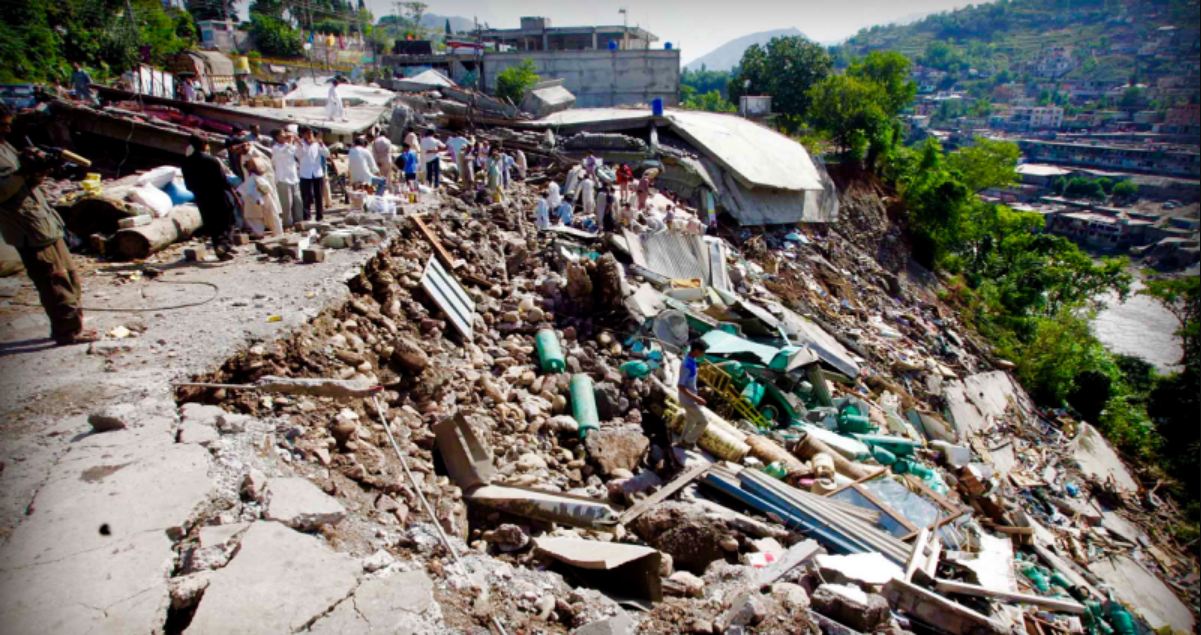Who says that humans forget everything, that wounds heal, that the heart becomes content, and that everything returns to how it was before? No, not. Things never go back to the way they were. Take October 8, 2005, as an example, when that morning appeared as a catastrophe. The sun that day rose as a dark sun, and the bright day turned to dust, debris, and smoke. It was that fateful morning of October 8 at 8:52 AM when a 7.6 magnitude earthquake shook the earth, destroying everything in its path.
Ah, I remember that day—the holy month of Ramadan. We had fasted, and I was preparing for my first-year exam, studying while enjoying the chirping of birds by the window. Suddenly, the bed began to shake violently. At first, I thought some unseen force had attacked. Then I thought maybe my younger brother had shaken the bed, so I called out to him and looked under the bed, but no one was there. Fear gripped me. I looked around and saw the entire room swaying from side to side. The only word that escaped my lips was “earthquake,” and I jumped off the bed and ran toward the stairs, calling out to my older sisters and parents as I ran. We rushed outside to the porch, but it was difficult to even stand on solid ground. We held onto the walls for support, but our legs were trembling. Our hearts were pounding with fear, feeling like everything would end. We barely made it past the gate, holding each other’s hands as we moved forward, then stopped. Everyone had come out of their homes, but fear was etched on every face. We kept repeating, “Allah is great, there is no God but Allah,” until the earthquake finally subsided, and a strange silence took over everything.
We went back inside the house, still shaken from experiencing such a massive earthquake for the first time. We didn’t know that severe aftershocks would follow. My father turned on the TV to check the earthquake’s intensity. Soon, a breaking news strip appeared on the screen: “Magnitude 7.6 earthquake.” My late father said, “Allahu Akbar, this is very dangerous. There must have been great destruction.” The next piece of news confirmed his fear: “Margalla Towers in Islamabad have collapsed.” My father froze. Though we had never seen Margalla Towers before, my father had. He said, “It was a huge tower; this is a major disaster.” Just then, the aftershocks began again, with another earthquake of around 7.3 magnitude. We kept running outside and back inside repeatedly. When it was time to break the fast, we would raise our hands for prayer, only to feel another tremor, forcing us to quickly eat a date and rush outside.
As more news started coming in from Kashmir, it felt like Judgment Day had arrived, like the world was coming to an end.
There was fear everywhere. People were afraid to go inside their homes, worrying that their houses or apartments might collapse. Aftershocks continued for a month. Experts said that aftershocks could occur for a month or more after a powerful earthquake. That devastating earthquake on October 8 left 3 million people homeless and claimed 88,000 lives. The earthquake also leveled Margalla Towers in Islamabad’s F-10 sector, where 157 people were present, including women and children. Out of them, 73 tragically lost their lives. The scenes shown on TV were filled with debris everywhere. The devastation in Kashmir was so horrific that it made one’s soul tremble. At that time, there was a strong trend of Girl Guides in schools and colleges. These Girl Guides acted like soldiers in difficult times. I was also part of the Girl Guides, and our teachers took us to PIMS hospital, explaining how we were to assist the nursing staff there.
I remember when we arrived at the gates of PIMS hospital, we had just stepped out of the vehicle when a helicopter, flying only a few feet above our heads, landed in the hospital’s lawn, which was as small as a park. From it descended English female army officers who immediately began their work. Everywhere in the hospital, there were injured women, children, and men, crying out in pain, while lifeless bodies lay helpless on stretchers.
The wounds were unbearable to look at. Cries and screams filled the air. A woman from Azad Kashmir, whose spine had been broken under the debris, lay alone on a hospital bed. She had no home, no shelter, and was in physical agony that prevented her from straightening up. On top of that, her heart was shattered by the loss of her husband and children. We didn’t know what words of comfort to offer her, as at that age, we didn’t fully grasp the meaning of comfort.
We moved ahead when a nurse called out for help. There was a 14 or 15-year-old girl whose blood-soaked hair needed washing. Her hair was matted together, but the middle part of her scalp was bare, with her brain exposed. We were terrified, afraid of making a mistake. Several women who were severely injured, their bodies riddled with wounds, pleaded, “For God’s sake, bring our children back! Our home is gone, everything is gone.” It was as if the hour of doom had struck, and most of the victims were women and children, who had lost not just a roof over their heads but everything they owned. The atmosphere was filled with such horror that even loved ones couldn’t provide solace.
I remember even in such a time, some selfish people took advantage of others’ fear. Parks were set up with tents for the residents of flats, and people were advised not to enter their homes. During this time, thefts occurred in some of their homes. Sadly, every era has its share of insensitive people, but that day of pain and anguish remains etched in the hearts and minds of everyone, even 19 years later.
In 2024, I was tasked with reporting on the devastating earthquake of 2005, and as I spoke to different people, their responses confirmed one thing: some wounds never heal.
Haider Shah, a resident, said he was working near Chakri Road in October 2005 and was on the street when the earthquake hit. The ground shook so violently that he fell almost 100 feet away. He recalls the scene being very strange, and the destruction in Islamabad, Kashmir, and Khyber Pakhtunkhwa added to the worry. Sayed Haider said that he still feels fear every October 8.
K. Asif, another resident and journalist by profession, said that he was playing cricket in a field when the earthquake struck. He described a strange noise that accompanied the shaking, and even now, he becomes sorrowful when he remembers how that day changed everything. He said that when he visited the earthquake victims, their wounds pierced his heart.
Another resident, Muhammad Aamir Naqshbandi, said that the memory of that day still sends shivers down his spine. A strange fear lingers in his heart. He prayed that such a day would never come again.
Another resident, Muhammad Manzoor, recalled that when Margalla Towers collapsed, cries could be heard from under the rubble, and there was confusion everywhere. He said that he never wants to remember that day, but it’s impossible to forget.
Yes, it’s true, no one forgets the pain of that earthquake—it was a national tragedy. The names of those who died in Margalla Towers were written on a small monument, but the tower was never rebuilt. Today, a new tower is being constructed in its place. Standing there, remembering the scenes of 2005, a single painful cry echoed in my heart:
Neither the dwellers remain, nor does the dwelling.
That scene of catastrophe,
Life didn’t even grant a moment’s respite.
New dwellers will return to these new homes,
But how will the wounds of separation heal?
The names remain, but the traces have all vanished.
The remnants of that old building are gone.
Oh, that scene of catastrophe!
That moment when cries and sighs buried the earth,
Years have passed, yet that haunting moment is etched on the heart,
Oh, that scene of calamity!
Written by Rozina Ali


Comments are closed, but trackbacks and pingbacks are open.